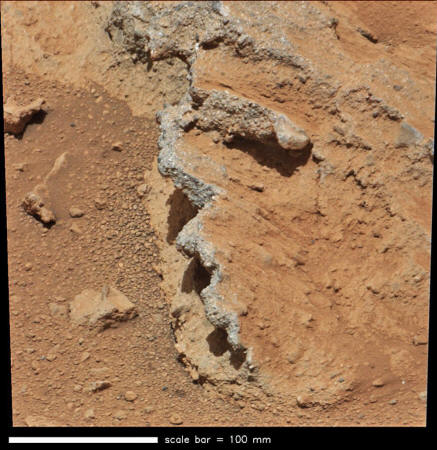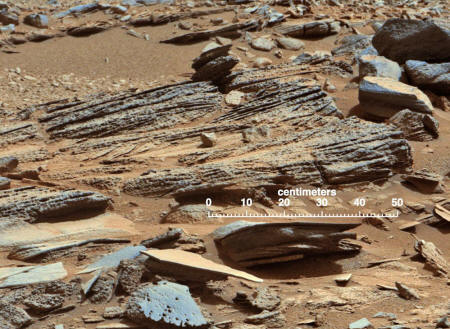|
from
Space Website
which appears to be
part of an ancient riverbed.
LONDON
Water, water everywhere, and some of it fit to drink.
Thatís the picture of ancient Mars that has emerged during the past few months thanks to discoveries by NASA's Curiosity rover, which has been exploring the Red Planet since touching down inside Gale Crater in August 2012.
The announcements have come in dribs and drabs, but presented together recently here at the European Planetary Science Congress, they provide compelling evidence that Mars was quite wet in the distant past.
During many sessions at the conference, which was held Sept. 8 to Sept. 13 in London, scientists presented details of the roverís most exciting finds, made before it began the long drive toward the towering Mount Sharp this past July.
And the words that could be heard most often were hydrogen, hydration, rocks and water. Especially water.
She talked about rocks that Curiosity studied earlier this year, finding evidence that ancient Mars could have supported microbial life.
Martian lakes?
One of the rocks Rice mentioned was a mudstone that Curiosity drilled into. Inside, researchers found clay minerals, which meant either formation in, or substantial alteration by, water on Mars.
Further, this water had to be neutral and benign.
That's a big deal as far as habitability goes; Curiosity's smaller, older cousins, NASA's Spirit and Opportunity rovers, found plenty of evidence of ancient Martian water after touching down in 2004, but most of it was likely extremely acidic.
Researchers think the mudstone formed in a place where water was calm, such as a lake - perhaps an ideal place for microbes to survive and reproduce.
Another rock that received a lot of attention at the conference is Tintina, a tiny pebble that Curiosity rolled over and broke apart.
The small piece of rock revealed a snowy-white interior, strongly hinting at the presence of hydrated minerals that formed when water flowed through Gale Crater billions of years ago.
This image from the Mast Camera (Mastcam) on NASA's Mars rover Curiosity shows inclined layering known as cross-bedding in an outcrop called "Shaler" on a scale of a few tenths of meters, or decimeters (1 decimeter is nearly 4 inches).
Image released
January 15, 2013.
Flowing rivers
More strong evidence of Mars' wet past comes from Curiosityís discovery of calcium sulfate veins - fissures in the surface rock that, once sampled with a laser-firing instrument called ChemCam, were shown to contain sulfate.
And then there are the ancient river deposits.
One such feature of the Martian landscape, studied by Curiosity while it was at a small depression near its landing site called Yellowknife Bay, is an outcrop researchers dubbed Shaler.
Shaler is an example of cross-stratification, which comprises thin, inclined layers of sediment. Features resembling Shaler are commonly formed by rivers here on Earth; turbulent water creates "dunes" on the riverbed, which slowly migrate in the direction of the current.
What Curiosity has seen are the remnants of that migration process, researchers said.
The water flows that produced the dunes probably occurred billions of years ago, Sanjeev Gupta said.
Scientists are still analyzing Curiosity's images of the deposits, a process that will take months, he added.
Trek to Mount Sharp
Curiosity is now embarked on a long journey to Mount Sharp, which rises 3.4 miles (5.5 kilometers) into the Martian sky from Gale Crater's center. The 1-ton rover may finally arrive at the mountain's base next May or June, team members say.
Curiosity will then climb up through Mount Sharp's lower reaches, studying the many rock layers as it goes.
Another goal is to analyze rocks containing clay minerals at the foothills of Mount Sharp, and understand how they changed into rocks containing sulfate minerals.
Mount Sharp has been Curiosity's primary destination since before the rover's November 2011 launch.
Mission scientists are eager to find out what the rover discovers there.
|


